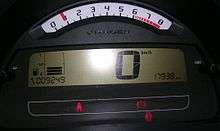Electronic instrument cluster
.jpg)
.jpg)

In an automobile, an electronic instrument cluster, digital instrument panel or digital dash for short, is a set of instrumentation, including the speedometer, that is displayed with a digital readout rather than with the traditional analog gauges. Many refer to it simply as a digital speedometer.
History

The first application of an electronic instrument cluster, in a production automobile, was in the 1976 Aston Martin Lagonda. The first American manufacturer application was the 1978 Cadillac Seville with available Cadillac Trip Computer. In the United States they were an option in many motor vehicles manufactured in the 1980s and 1990s, and were standard on some luxury vehicles at times, including some models made by Cadillac, Chrysler and Lincoln. They included not only a speedometer with a digital readout, but also a trip computer that displayed factors like the outdoor temperature, travel direction, fuel economy and distance to empty (DTE). In 1983, the Renault 11 Electronic was the first European hatchback to have a digital dashboard.[1] Many vehicles made today have an analog speedometer paired with the latter in digital form. In the late 1980s into the early 1990s, General Motors had touch-screen CRTs with features such as date books and hands-free cell phone integration built into cars such as the Oldsmobile Toronado, Buick Riviera and Buick Reatta.
Problems
Digital speedometers have limitations. For example, while an analog speedometer can theoretically display an infinite number of speeds, digital speedometers generally display speeds in whole numbers.[2][3][4]
Digital dashes were considered to be unpopular during the years when they were widely produced, and were heavily criticized by reviewers in automotive magazines. Some of the criticism they received was as follows:
- They were hard to see in the strong sunlight or other bright light
- They took away the sense of continuous acceleration that is provided by an analog speedometer.[5]
- They were expensive to repair in the event of a malfunction
As a result of these issues, digital instrument panels were phased out of vehicles throughout the 1990s, and have been replaced with traditional analog gauges in most vehicles (with notable exceptions from French manufacturers Renault and Citroën), including those from luxury divisions. However, many vehicles are made today with a standard or optional trip computer located independently from the speedometer.
Digital units received information from a variety of sensors installed throughout the engine and transmission, while traditional analog units were attached to a cable that provided information from the transmission. Modern analog displays receive information in the same manner as the digital units, with very few manufacturers still using the speedometer cable method.
Digital dashes in the 2000s

In the 2000s, digital speedometers have been produced in some hybrid vehicles, including the Toyota Prius and Honda Civic.[6]
Most digital speedometers have had green numbers displayed on a dark green or black background. The current model Honda Civic has an upper digital dashboard with white numbers against a blue screen, digital fuel and temperature gauges. The lower dashboard has an analog tachometer and digital odometer. Automotive head-up displays have seen applications in several cars, augmenting analog gauges with a digital readout on the windshield glass.
Many modern motorcycles are now equipped with digital speedometers, most often these are sports bikes.
Toyota is using electronic instruments for showing the cars parameters for its Yaris/Vitz model, the car employs a Vacuum fluorescent display to indicate the speed, RPM, fuel level, odometer, etc.
For the 2011 model year, Chrysler began using a common dashboard across their model line that has an integrated trip computer in addition to the analog gauges. This trip computer can also be used to show a digital speedometer, making these hybrid digital-analog dashboards. Because many drivers perceive the speedometer needle to be too wide, they are relying on the digital speedometer more than the analog gauge.
The French manufacturer Citroën, is using digital indicators as speedometer for many models in its range, including the C2, C3, C4 and C6.
LCDs


Automakers have begun offering vehicles with LCD instrument clusters that display "analog" gauges on screen, while integrating additional interactive features.
In 2014, Audi launched [7] its 'virtual cockpit' on Audi TT, and has later introduced it to the several other models. The technology has been developed [8] together with the Finnish company Rightware, using its Kanzi software suite.
See also
References
- ↑ "Fiat Tipo". carsfromitaly.net. Retrieved 2009-12-25.
- ↑ Refrigeration & air conditioning ... - Google Books. Books.google.com. Retrieved 2009-12-08.
- ↑ The compact disc handbook - Google Books. Books.google.com. Retrieved 2009-12-08.
- ↑ Popular Science - Google Books. Books.google.com. Retrieved 2009-12-08.
- ↑ Information technology for energy ... - Google Books. Books.google.com. Retrieved 2009-12-08.
- ↑ "3rd Generation Toyota Prius - 2010 Pictures and Photo Gallery". Toyota.com. Retrieved 2009-12-08.
- ↑ Gibbs, Samuel (29 March 2014). "Audi builds hi-tech 'virtual cockpit' into the new TT". The Guardian. Retrieved 22 December 2015.
- ↑ Singh, Sarbjeet (14 October 2015). "Audi pushing more virtual cockpit clusters with Rightware for next-generation A3, A4, Q7, others". IHS Technology. Retrieved 22 December 2015.
External links
| ||||||||||||||||||||||||||||||||||||||||||||||||||